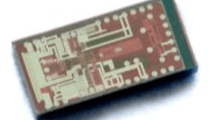CMOS Transceiver hits 7 Gbps in 60 GHz Band
on

More and more data-intensive applications are running on modern wireless consumer electronic products, and communication channels below 10 GHz, such as WLAN, are confronted with spectrum scarcity. Wireless system designers are therefore compelled to explore higher frequency bands, such as the unlicensed 60 GHz band. This band is available throughout the world and allows multi-Gbps wireless communication over short distances. However, the cost, footprint and power consumption must be drastically reduced to enable deployment of 60 GHz wireless communication technology in portable mass-market products.
An important step towards the deployment of 60 GHz technology is the new prototype transceiver front-end IC developed by Imec and Panasonic that achieves a 7 Gbps data rate over short distances in the four channels specified by the IEEE 802.11ad standard with QAM16 modulation and an error vector management figure better than -17 dB. The transmitter signal path, consisting of a power amplifier and a mixer, consumes 90 mW with 10.2 dBm OP1dB. The receiver signal path, consisting of a low-noise amplifier and a mixer, consumes 35 mW and has a noise figure of 5.5 dB and 30 dB gain. Electrostatic discharge robustness is over 4 kV with a human body model. The compact 0.7 mm³ core area makes the transceiver front-end especially suitable for use in phased arrays. The small area is achieved by using lumped components and very compact millimeter-wave CMOS layout methods.


Discussion (0 comments)